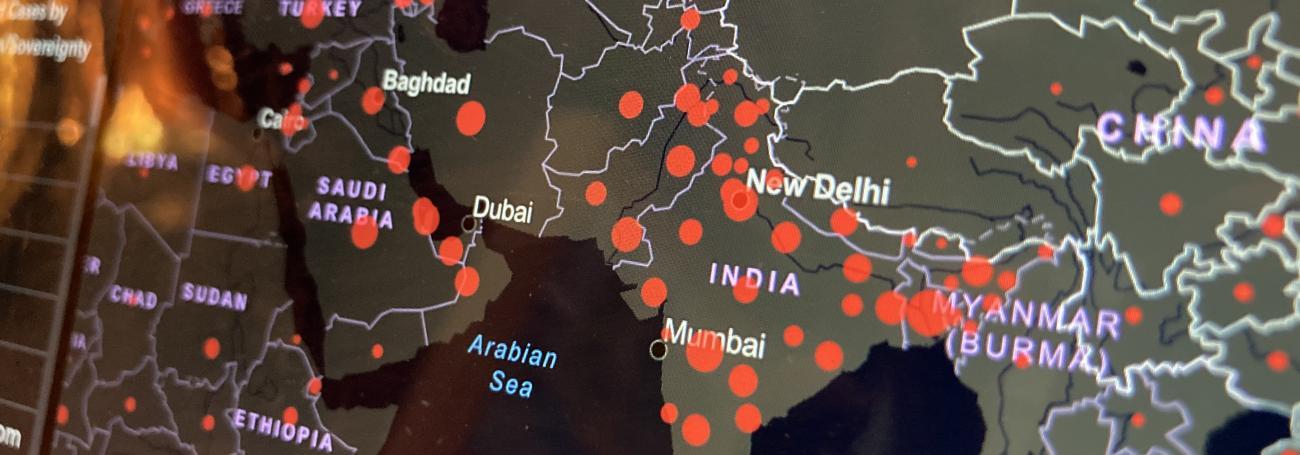
"The first problem for all of us, men and women, is not to learn but to unlearn."
Gloria Steinem

"The first problem for all of us, men and women, is not to learn but to unlearn."
Gloria Steinem
Covid-19 has had a severe and widespread impact in the world. Apart from the direct ramifications of the virus, there have been far-ranging ripples at individual, collective and systemic levels. This piece reflects on the layered impact in India and the scope of restorative spaces as we respond to the pandemic.
India saw its first Covid-19 case on January 30, 2020. The government declared the pandemic as a ‘disaster’ and invoked the national statute on disaster management. India went into lockdown on March 24, 2020 and this lockdown continues to date with graded relaxations. As of 14 June 2020, 333,255 people have tested positive, and 9,524 people have lost their lives to the virus.
The pandemic has exacerbated existing inequalities and impacted people disproportionally: those living on the margins are more vulnerable to adverse consequences. For those already economically and socially disadvantaged, the lockdown has put survival and livelihood at stake. The most severely impacted include those working in the informal sector, migrant workers, the homeless, those pushed to the margins because of economic/social or religious identity, people involved in the legal system, those affected by physical and mental health impairments and difficulties and those adversely affected by gender inequity.
India’s migrant workers are severely impacted. Twenty million people travel within India in the search of work and income, with 7.5 million having daily or weekly payment arrangements. They work in the informal economy, a sector fraught with asymmetrical power relations and the absence of job security and regulatory mechanisms. The lockdown shut off movement and resources and exacerbated the situation and forced them to stay in alien cities without income and food. More than ten million migrant workers are left unemployed, many forced to walk hundreds of miles to their home towns. The authorities have treated them in ruthless and dehumanising ways: sprayed with disinfectant, left starving for days and subjected to brutal physical violence. The highest court of India, the Supreme Court, abstained from taking action for two months. Though the High Courts of some states stepped in, the anguish continues. In addition to the uncertain job prospects for these workers, some states diluted labour laws and protective measures, jeopardising workers’ rights and subjecting them to callous working conditions.
Gender inequality has also heightened owing to the increased disproportionate burden on women of the care economy, i.e. taking care of household chores, children and older people. Of the women working in India, 94% are engaged in the informal sector and face an increased risk of job insecurity. The economic distress may push women to seek employment on underpaid and unfair conditions, akin to earlier agrarian distress induced employment.
There is also an increased risk of domestic harm for women and children owing to home confinement and factors which may exacerbate the perpetuation of such harm (including economic instability). The gendered disproportionate impact also manifests itself on transgender people who were already subject to discrimination, and many of whom who faced health difficulties and challenges in accessing healthcare.
Children are also at severe risk because of the pandemic and lockdown. Of the migrant people travelling home, many are children, forced to walk hundreds of kilometres or face other gruelling circumstances. For children from economically disadvantaged families, education through digital platforms is often a distant reality. Owing to the loss of income for many families and disruption in the children’s education, many families may be compelled to push their children into child labour. Many children have been left without caregivers, either temporarily or permanently. As a result, children are prone to a plethora of vulnerabilities including abuse, child labour, child trafficking and child marriage.
Another harmful manifestation of the lockdown is the communalised response, amplifying pre-existing fault lines in India’s social fabric. The majoritarian narrative falsely portrayed the spread of the pandemic as a conspiracy by, or attributable to, certain Muslims in India based on a religious congregation that took place before the lockdown and resulted in the attendees being impacted by the virus. Biased media reports, violence, stigma and discriminatory behaviour ensued, targeting Muslims across the country and depriving them of basic healthcare. The Supreme Court responded inadequately to the discrimination.
In addition, other minorities were also callously targeted during the pandemic. This includes people from north-east India, with discriminatory ‘othering’ amplifying against them. Many people from the north-east were baselessly blamed for the virus, many evicted from their rented homes and subject to a host of other discriminatory treatment.
In addition, the lockdown and the pandemic have both, exacerbated and created, mental health difficulties. Mental health is an extremely under-focussed domain in India, despite the fact that mental health problems continue to impact a substantial proportion of people. The pandemic is triggering and generating trauma in varied intensities. While some therapists are offering online therapy, it is accessible to a very minute percentage of those who need it, and even those using this facility are facing challenges. Misinformation and stigma surrounding mental health, financial costs, as well as the lack of privacy in homes pose hurdles to accessing meaningful mental health support.
While the impact is distressing, the country is responding in manifold ways to the pandemic. State and civil society responses have worked to provide multiple interventions. Some states have been perceived to act more efficiently and effectively than others. Civil society has stepped in to fill the gaps left by government interventions including food distribution, food supply and distribution of safety equipment, especially for those who are on the margins. Civil society continues to be a force multiplier, with some surveys indicating that civil society has outperformed the state in certain areas with providing food and supplies.

The criminal legal system has also faced the impact of the lockdown. The partial closure of courts has disrupted and further delayed access to justice in an already overburdened judicial system. In addition, prisons are vulnerable to the spread of the infection owing to the proximity of people, with most prisons housing more people than intended capacity. People in prison are no longer allowed to meet their family members to reduce the chance of infection; however, this has a psychological toll. A few prisons are allowing video conferencing, but since the use of this technology is in a birthing stage, it will take time for it to realise its potential.
Despite the precautions, the pandemic did mercilessly spread in Indian prisons, attacking multiple prisoners and prison staff across jails in India. The Supreme Court recognised the danger to prisoners’ health and issued directions. People who were in prison and under trial were released in significant numbers across the country; some people who had been convicted were also released on either parole or furlough. However, compounded by the stigma of imprisonment, these people are likely to face barriers in transitioning to life outside custody. While Covid-19 highlights a set of flaws in the prison system and other custodial institutional settings, prisons are inherently flawed in multiple ways. From my earlier work with people in prisons, including women in India’s largest prison, I saw how prisons fail to ensure accountability, have a severe psychological and social toll and fail to ensure reintegration; rather they render it unlikely.
Figure: ‘ … light coming into the darkness, much like how I like to think of restorative work’
The pandemic is encouraging people to reinvent the way businesses work; this may also an opportunity to re-examine justice systems, especially in the light of the harm they perpetuate. While virtual courtrooms and hearings are one aspect of the legal system’s response to the pandemic, we can also draw inspiration from Gloria Steinem’s words: ‘the first problem for all of us is not to learn but to unlearn.’ The pandemic can be an opportunity to unlearn our reliance on, and addiction to, institutions which incarcerate individuals. This may be an apt reminder that we need to move towards a society where we respond to violence with healing, rather than responding with more violence. We need to reduce the number of people we throw into prison. This becomes even more important since, post the easing of the lockdown, crime rates may increase, compounded by unemployment.
Restorative justice is, at its core, about healing the harm done through crime. An additional, invaluable benefit could be that it helps reduce reliance on the prison system. While some organisations in India are already implementing restorative justice pilot programmes, restorative justice has massive potential in the coming few years.
In addition, restorative spaces may be a helpful collective response supplementing the responses to the pandemic beyond the basic needs of food, shelter, health, physical and emotional safety, self-care and sustenance. While restorative justice in India is specific to crime and wrongdoing, other restorative spaces could have massive potential in the times of the pandemic, the lockdown and its easing.
Like elsewhere in the world, restorative circles have been reimagined in virtual ways using video conferencing. Circles are different from other virtual meetings as they
For example, taking a minute for a collective mindfulness practice can help participants transition into the circle space. These circles create space for connection in the midst of physical distancing.
Some organisations, including my organisation, Counsel to Secure Justice, are conducting circles for children in custodial and protective institutional settings. These spaces help children to have meaningful engagement and also have a safe space to voice concerns and worries.
Restorative justice and practices have beautiful lessons to offer as we navigate our way through the pandemic. Restorative practices are premised on our interconnectedness and how we are all responsible for each other. Creating spaces to share experiences in a safe space is a starting point in collectively responding to the pandemic. Outside the criminal legal system, restorative spaces are being used collectively to navigate the impact of the pandemic. Healthcare professionals are participating in listening circles to navigate the impact of their work. My organisation is holding circles for professional caregivers, such as counsellors working with children in distress. Participants who’ve come to circles I’ve hosted have spoken about feeling lighter after coming to these spaces and cherishing a space to focus on themselves.
Other circles are open to people from different walks of life and focus on navigating the pandemic. In the circles I’ve hosted, we’ve explored the impact of the pandemic, uncertainty, anxiety, mental health and ways to find hope and gratitude in these times. Potentially, these spaces could also function as support spaces for people being subject to systemic and identity-based harm.
The pandemic may be a powerful reminder that we need collective and inclusive solutions. The rupturing effects of the lockdown have enhanced existing systemic cracks. Apart from addressing individualised harm, restorative spaces can pave the way for a new normal which can begin to work towards social transformation and solidarity. Restorative spaces can provide people severely impacted by the pandemic with a space to come together within their own communities collectively to work through their pain. Restorative spaces may also be one of the aspects of working towards bridging social divides on the lines of communal hatred, and othering and segregation. Restorative processes create spaces to talk about and acknowledge the perpetuation of systemic harm and ways in which we may want to redefine this, going forward.
This pandemic may be an opportunity to foster a bold vision and create a future that doesn’t go back to the old normal, but creates a new normal defined around repairing fault lines and generations of harm, while prioritising voice, community, inclusion and respect.

Arti Mohan is a Restorative Justice Program Officer at Counsel to Secure Justice, New Delhi arti9mohan@gmail.com